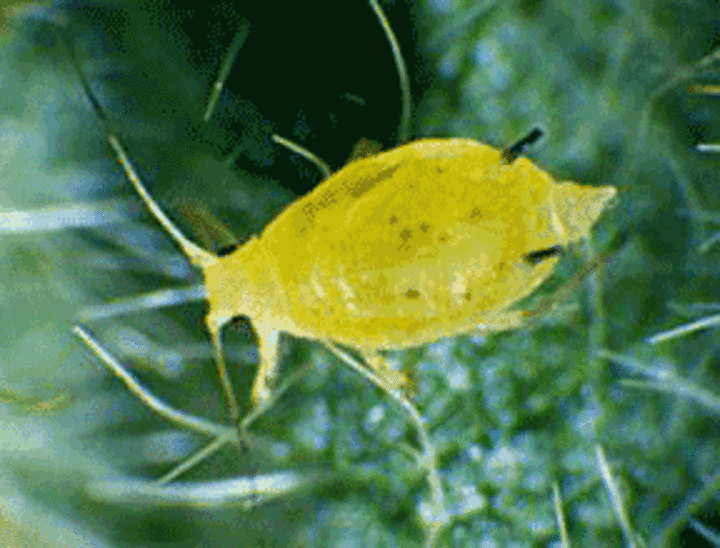July 1, 2009

|
| Soybean aphid |

|
| Soybean aphids on a single leaf, 2002. In Minnesota, as many as 13,000 soybean aphids have been found on a single plant. |
Soybean Aphid Occurrence |
We've had reports of very low populations of soybean aphids in northeast Nebraska in the last week. This is not unusual. We usually begin to find a few in June. Recent high temperatures probably limited population growth of those that were present.
Having said that, don't forget that if temperatures are moderate in July, aphid populations can increase very fast. Last year we had a relatively cool July (temperatures did not exceed 90°F at Concord), and aphid populations exploded in much of Nebraska. In any case, if you have not begun scouting soybean for soybean aphid, now is the time to begin.
Soybean Aphid Description
The aphid is light green to pale yellow, less than 1/16 inch long, and has two black-tipped cornicles (cornicles look like tailpipes) on the rear of the abdomen. It has piercing-sucking mouthparts and typically feeds on new tissue near the top of soybean plants on the undersides of leaves. Later in the season the aphids can be found on all parts of the plant. It is the only aphid in North America that forms colonies on soybean.
Life Cycle
The seasonal life cycle of the soybean aphid is complex with up to 18 generations a year under optimal conditions. It requires two species of host plant to complete its life cycle: common buckthorn and soybean. Buckthorn is a woody shrub or tree and is the overwintering host plant of the aphid. Soybean aphids lay eggs on buckthorn in the fall. These eggs overwinter and hatch in the spring, giving rise to wingless females.
These females reproduce without mating, producing more females. After two or three generations on buckthorn, winged females are produced and migrate to soybean. Multiple generations of wingless female aphids are produced on soybeans until late summer/fall, when winged females and males are produced that migrate back to buckthorn, where they mate. The females then lay eggs on buckthorn, which overwinter, thus completing the seasonal cycle.
Soybean aphid populations can grow to extremely high levels under favorable environmental conditions. Reproduction and development is fastest when temperatures are in the 70s through the mid 80s. The aphids do not appear to do well when temperatures are in the 90s, and are reported to begin to die when temperatures reach 95°F.
When populations reach high levels during the summer, winged females are produced that migrate to other soybean fields. Like a number of other insect species (e.g. potato leafhoppers), these migrants can be caught up in weather patterns, moved great distances, and end up infesting fields far from their origin. These summer migrants were most likely the major source of infestations in Nebraska during the last couple of years.
Injury and Symptoms
Soybean aphids injure soybeans by removing plant sap with their needle-like mouthparts. Symptoms of soybeans infested by soybean aphid may include yellowed, distorted leaves and stunted plants. A charcoal-colored residue also may be present on the plants. This is sooty mold that grows on the honeydew that aphids excrete. Honeydew in itself makes leaves appear shiny. Soybean plants are most vulnerable to aphid injury during the early reproductive stages.
Tom Hunt, Extension Entomologist
Northeast REC Haskell Ag Lab, Concord
Keith Jarvi, IPM Assistant
Northeast REC, Norfolk
